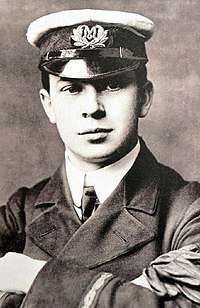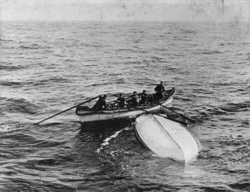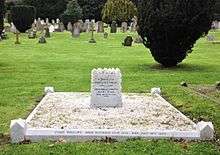Jack Phillips (wireless officer)
John George "Jack" Phillips (11 April 1887 – 15 April 1912) was a British sailor and the senior wireless operator aboard the Titanic during its ill-fated maiden voyage in April 1912.
Jack Phillips | |
|---|---|
 | |
| Born | 11 April 1887 |
| Died | 15 April 1912 (aged 25) North Atlantic Ocean |
| Nationality | British |
| Occupation | Wireless telegraphist |
| Parent(s) | George Alfred Phillips Anne Sanders |
On the final evening, Phillips had been exceptionally busy clearing a backlog of messages caused by a wireless breakdown. His consequent failure to respond to incoming signals is cited as a principal cause of the disaster. When the steamship Mesaba sent an ice alert, he acknowledged it, but failed to pass it on to the bridge. Another from the nearby SS Californian was ignored altogether. After they struck the iceberg, however, Phillips was seen to be doing his utmost to contact other ships for assistance. There are contradictory reports of his death, and his body was never found.
Biography
Phillips was born on 11 April 1887 in Farncombe, Surrey.[2] The son of George Alfred Phillips, a draper and Ann (née Sanders), Phillips' family originally came from Trowbridge, Wiltshire, from a lineage of weavers, but moved to Farncombe around 1883.[2] Phillips lived with his five siblings, of whom only two twin sisters survived to adulthood, above a draper's shop – Gammons – which his father managed in Farncombe Street.[2] Educated at a private school on Hare Lane, then St John Street School, Phillips sang as a choirboy at St John the Evangelist – Farncombe's church.[2]
He finished school in 1902 and began working at the Godalming post office, where he learned telegraphy. He started training to work in wireless for the Marconi Company in March 1906, in Seaforth, and graduated five months later in August. Phillips's first assignment was on the White Star Line ship Teutonic. He later worked on board Cunard's Campania; the Allan Line's Corsican, Pretorian and Victorian; and then Cunard's Lusitania and Mauretania. In May 1908, he was assigned to the Marconi station outside Clifden, Ireland, where he worked until 1911, when he was assigned to the Adriatic and later, in early 1912, to the Oceanic.
RMS Titanic
In March 1912, Phillips was sent to Belfast, Ireland, to be the senior wireless operator on board the Titanic for her maiden voyage. He was joined by junior wireless operator Harold Bride.[3] Stories have appeared that Phillips knew Bride before Titanic, but Bride insisted they had never met before Belfast.[1] Titanic sailed for New York City, United States, from Southampton, England, on 10 April 1912, and during the voyage Phillips and Bride transmitted passengers' personal messages and received iceberg warnings and other navigational information from other ships. Phillips celebrated his 25th birthday the day after the voyage began.
On the evening of 14 April, in the wireless room on the boat deck, Phillips was sending messages to Cape Race, Newfoundland, working to clear a backlog of passengers' personal messages that had accumulated when the wireless had broken down the day before.[3] Bride was asleep in the adjoining cabin, intending to relieve Phillips at midnight, two hours early. Shortly after 9:30 pm, Phillips received an ice warning from the steamship Mesaba reporting a large number of icebergs and an ice field directly in Titanic's path. Phillips acknowledged Mesaba's warning and continued to transmit messages to Cape Race. Mesaba's wireless operator waited for Phillips to report that he had given the report to the bridge, but Phillips continued working Cape Race. The message was one of the most important warnings Titanic received, but it was never delivered to the bridge.
Second Officer (Second Mate) Charles Lightoller reports in Chapter 31 of his autobiography:
Phillips explained when I said that I did not recollect any Mesaba report: "I just put the message under a paper weight at my elbow, just until I squared up what I was doing before sending it to the Bridge." That delay proved fatal and was the main contributory cause to the loss of that magnificent ship and hundreds of lives. Had I as Officer of the Watch, or the Captain, become aware of the peril lying so close ahead and not instantly slowed down or stopped, we should have been guilty of culpable and criminal negligence.[4]
At 10:55 pm, Phillips was again interrupted by another ship, this time the SS Californian. Californian's only wireless operator, Cyril Evans, was reporting that they were stopped and surrounded by ice. Californian's relative proximity (and the fact that both Evans and Phillips were using spark gap wireless sets whose signals bled across the spectrum and were impossible to tune out) meant that Evans's signal was strong and loud in Phillips's ears, while the signals from Cape Race were faint to Phillips and inaudible to Evans. Phillips quickly sent back, "Keep out; shut up, I'm working Cape Race", and continued communicating with Cape Race, while Evans listened a while longer before going to bed for the night.
It can be argued that this communication had important consequences: Firstly, Evans was giving a warning of ice, which, if heeded, could have prevented Titanic's sinking. Secondly, Californian was the closest ship to Titanic. As the radio had been switched off by Evans, Phillips had no way of communicating with Californian should Titanic require immediate assistance, which she very soon did. However, others point out that several ice warnings had already been received and communicated to the captain, so he was aware that there was ice in the area, and a lookout had been posted.
Furthermore, Evans did not request that the message be delivered to the bridge, and the crew of Californian did see the rockets from Titanic at 12:47 AM and woke their captain, who chose to ignore the rockets and returned to bed.
Titanic struck an iceberg at 11:40 PM that night and began sinking. Bride had woken up and begun getting ready to relieve Phillips, when Captain Edward Smith came into the wireless room and told Phillips to prepare to send out a distress signal. Shortly after midnight, Captain Smith came in again and told them to send out the call for assistance and gave them Titanic's estimated position. Phillips began sending out the distress signal, code CQD, while Bride took messages to Captain Smith about which ships were coming to Titanic's assistance. At one point, Bride jokingly reminded Phillips that the new call was SOS and said, "Send S.O.S., it's the new call, and it may be your last chance to send it."[3][5] (A myth developed after the disaster that this was the first time SOS was used, but it had been used on other ships previously.[6])
After taking a quick break, Phillips returned to the wireless room and reported to Bride: the forward part of the ship was flooded, and they should put on more clothes and lifebelts. Bride began to get ready, while Phillips went back to work on the wireless machine.
The wireless power was almost completely out shortly after 2:00 am, when Captain Smith arrived and told the men they had done their duty and were relieved. Bride later remembered being moved by the way Phillips continued working. While their backs were turned, a crew member (either a stoker or trimmer) sneaked in and attempted to steal Phillips's lifebelt. Bride saw and grabbed the man as Phillips stood up and knocked the crew member out. The water was beginning to flood the wireless room as they both ran out of the wireless room, leaving the unconscious crewman where he fell. The men then split up, Bride heading forward and Phillips heading aft.[5] This was the last time Bride saw Phillips.[5]

For many years, there has been conflicting and contradictory information regarding the exact manner in which Phillips met his death. Many researchers have expressed the belief that Phillips managed to make it to the overturned lifeboat B, which was in the charge of Second Officer Charles Lightoller, along with Harold Bride.
In Lightoller's autobiography, Titanic and Other Ships, he writes,
"Phillips, the senior wireless operator, standing near me, told me the different ships that had answered our call ..."
"... As it turned out, the information from Phillips, and the calculation, were about right, though poor old Phillips did not live to benefit by it. He hung on till daylight came in and we sighted one of the lifeboats in the distance ..."
"... I think it must have been the final and terrible anxiety that tipped the beam with Phillips, for he suddenly slipped down, sitting in the water, and though we held his head up, he never recovered. I insisted on taking him into the lifeboat with us, hoping there still might be life, but it was too late."[7]
Bride reported seeing Phillips's body as he boarded the Carpathia.[5]
However, Lightoller's and Bride's claims about Jack Phillips are contradicted elsewhere by Archibald Gracie, who made it clear that the wireless operator who cheered up the occupants of the upturned collapsible by calling out the names of approaching ships was Harold Bride, not Jack Phillips (as Lightoller thought in 1934.) It is also clear from the accounts of Gracie and Lightoller that only one body was transferred from the collapsible onto boat #12. Bride stated that he knew the body of "the man lying aft" was transferred to #12—which was undoubtedly the body of the crewman mentioned by Gracie and which Lightoller (in 1912) agreed was the body of a crewman. Bride's assumption that the body of Phillips (which he never saw) was also taken on board the Carpathia was just that - an assumption (since he obviously did not see Phillips's body lying abandoned in #12 after the boat was emptied of living passengers.)[8]


There are memorials to Jack Phillips in Nightingale Cemetery, Farncombe and in the Phillips Memorial Cloister, part of the Phillips Memorial Ground, which lies to the north of the Church of St Peter & St Paul, Godalming.
To mark the 100th anniversary of the sinking, the BBC World Service broadcast, on 10 April 2012, a radio documentary in the "Discovery" series, entitled Titanic – In Her Own Words. The programme was conceived and created by Susanne Weber and was narrated by Sean Coughlan, who had previously written a book on the Titanic radio messages.[9] The programme used voice synthesis to re-create "... the strange, twitter-like, mechanical brevity of the original Morse code messages ... " transmitted by Titanic and neighbouring ships. Messages often included the fashionable slang expressions of the time, such as "old man". The BBC noted that "these messages were recorded at the time in copper-plate handwriting, now scattered across the world in different collections, but together forming a unique archive."[10]
Notes
- "Mr. John George Phillips" (2014) Encyclopedia Titanica (ref: #2051, accessed 1 March 2014)
- "John George (Jack) Phillips, (1887 – 1912)". Godalming Museum. Exploring Surrey's Past. 2013. Retrieved 27 March 2017.
- "Wireless Man of Titanic Describes Wreck of Vessel". The Washington Times. 19 April 1912. Retrieved 18 May 2015.
- Charles Herbert Lightoller (1935) in Chapter 31. "Southampton" (eBook). Titanic and Other Ships. London: Ivor Nicholson and Watson. Retrieved 10 July 2010.
- Harold Bride, Surviving Wireless Operator of the Titanic (19 April 1912). "THRILLING STORY BY TITANIC'S SURVIVING WIRELESS MAN; Bride Tells How He and Phillips Worked and How He Finished a Stoker Who Tried to Steal Phillips's Life Belt – Ship Sank to Tune of "Autumn"". The New York Times. Retrieved 10 July 2010.
- Snopes.com: Titanic First Ship to Use an SOS?
- Charles Herbert Lightoller (1935) in Chapter 35. "The Rescue". Titanic and Other Ships. London: Ivor Nicholson and Watson. Retrieved 10 July 2010.
- "The Fate of Jack Phillips -George Behe's " Titanic " Tidbits".
- Booth, J. A. and Coughlan, S., (1993) "Titanic": Signals of Disaster, White Star Publications, ISBN 0-9518190-1-1, ISBN 978-0-9518190-1-2
- "Titanic – In Her Own Words". Discovery. BBC.
References
- Hyder, Jemma; Inger Sheil. "John George Phillips". On Watch: The Deck Officers and Wireless Operators of the R.M.S. Titanic. Archived from the original on 3 October 2002. Retrieved 25 July 2005.
- Lane, Allison; Stephenson, Parks. "Mr John George Phillips". Encyclopedia Titanica. Archived from the original on 24 September 2015. Retrieved 25 July 2005.
- Lightoller, C. H., (1935), Titanic and Other Ships, Nicholson and Watson.
- Lynch, Don (1993). Titanic: An Illustrated History. Hyperion. ISBN 0-7868-8147-X.
External links
| Wikimedia Commons has media related to Jack Phillips. |
- John Phillips' Memorial at Titanic-Titanic.com
- Jack Phillips & The Titanic – (Non-commercial site) information and images about Jack Phillips and the memorial to him